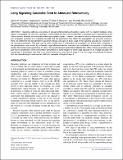Long Signaling Cascades Tend to Attenuate Retroactivity
Author(s)
Ossareh, Hamid R.; Ventura, Alejandra C.; Merajver, Sofia D.; Del Vecchio, Domitilla
Downloaddel Vecchio_Long signaling.pdf (334.1Kb)
PUBLISHER_POLICY
Publisher Policy
Article is made available in accordance with the publisher's policy and may be subject to US copyright law. Please refer to the publisher's site for terms of use.
Terms of use
Metadata
Show full item recordAbstract
Signaling pathways consisting of phosphorylation/dephosphorylation cycles with no explicit feedback allow signals to propagate not only from upstream to downstream but also from downstream to upstream due to retroactivity at the interconnection between phosphorylation/dephosphorylation cycles. However, the extent to which a downstream perturbation can propagate upstream in a signaling cascade and the parameters that affect this propagation are presently unknown. Here, we determine the downstream-to-upstream steady-state gain at each stage of the signaling cascade as a function of the cascade parameters. This gain can be made smaller than 1 (attenuation) by sufficiently fast kinase rates compared to the phosphatase rates and/or by sufficiently large Michaelis-Menten constants and sufficiently low amounts of total stage protein. Numerical studies performed on sets of biologically relevant parameters indicated that ~50% of these parameters could give rise to amplification of the downstream perturbation at some stage in a three-stage cascade. In an n-stage cascade, the percentage of parameters that lead to an overall attenuation from the last stage to the first stage monotonically increases with the cascade length n and reaches 100% for cascades of length at least 6.
Date issued
2011-04Department
Massachusetts Institute of Technology. Department of Mechanical EngineeringJournal
Biophysical Journal
Publisher
Elsevier
Citation
Ossareh, Hamid R., Alejandra C. Ventura, Sofia D. Merajver, and Domitilla Del Vecchio. “Long Signaling Cascades Tend to Attenuate Retroactivity.” Biophysical Journal 100, no. 7 (April 2011): 1617–1626. © 2011 Biophysical Society
Version: Final published version
ISSN
00063495
1542-0086